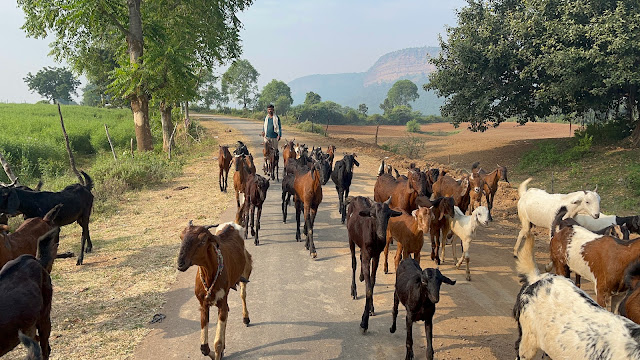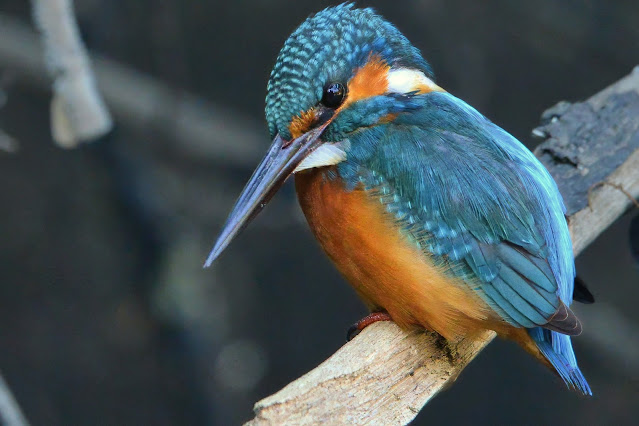Indian False Vampire Bats (Megaderma lyra) - Birds And More 016
Birds And More 016 - Indian False Vampire Bats (Megaderma lyra)
Riding my scooter through the newly paved village roads outside Jabalpur, I didn't realise how far I rode. A town about 35 km from Jabalpur, on the foot of the Vindhya Range, and famous for its massive Gulab Jamuns (deep fried sweet balls) - Katangi (Jabalpur). It was the trip I had done many times as a child and teen, but this time it was different.
 |
| Katangi (Jabalpur) October 2023 |
I wanted to see a critically endangered (CR) Indian vulture or long-billed vulture देशी गिद्ध (Gyps indicus). Through my binoculars, I saw them soaring at a distance and headed in that direction and after riding about a couple of km found a few perching on beautiful red rock cliffs. And I also saw a temple just below where these amazing scavengers were perched. I asked a local and he guided me to the path leading to steps towards the temple. After climbing about 600 steps, I not only saw a few common birds but was closer to about 20 vultures soaring and a few on their perches.
 |
| Katangi (Jabalpur) October 2023 |
 |
| Indian vulture or long-billed vulture देशी गिद्ध (Gyps indicus) Katangi (Jabalpur), October 2023 |
I was a bit tired, took some rest, removed my shoes, and walked towards the temple. And I was surprised to see 10s of bats hanging inside a narrow cave. I was overjoyed as I wanted to see these common bats for a long time - Indian False Vampire Bats (Megaderma lyra).
The Indian False Vampire Bat (Megaderma lyra) is a large, insectivorous bat found in tropical and subtropical regions of the Indian subcontinent and Southeast Asia. The Indian False Vampire Bat is a stocky bat with a broad head and a short snout. It has large ears that are folded back and are connected by a fleshy ridge. The bat's fur is short and brownish-gray, with lighter markings on the face and belly. Its ears are sensitive to high-frequency sounds, which helps it to locate prey in the dark.
 |
| Indian False Vampire Bats (Megaderma lyra) Katangi (Jabalpur), October 2023 |
The Indian False Vampire Bat is an insectivore, and its diet consists mainly of moths, beetles, and other large insects. It also eats spiders, scorpions, and small vertebrates. The bat uses its large ears and echolocation to locate prey in the dark. It then swoops down and catches its prey with its claws.
 |
| Indian False Vampire Bats (Megaderma lyra) Katangi, Jabalpur, October 2023 |
Here are some interesting facts about the Indian False Vampire Bat:
- They're not actually vampires: Despite their name, Indian False Vampire Bats don't feed on blood. They are insectivores, meaning their diet consists mainly of insects.
- They have giant ears: Their large ears, which can span up to 5 inches, are one of their most distinguishing features. These ears are not only sensitive to sound but also help them echolocate, allowing them to navigate and hunt in the dark.
- They're skilled hunters: Their combination of large ears, echolocation, and sharp eyesight makes them highly effective hunters. They can catch prey in mid-air or snatch it off the ground.
- They're social creatures: Despite being solitary foragers, Indian False Vampire Bats roost in groups of up to 50 individuals. They often roost in caves, hollow trees, or abandoned buildings.
- They play an important role in the ecosystem: By controlling insect populations, these bats help to protect crops and forests. They also play a role in seed dispersal, as they often consume fruits and then drop the seeds in new locations.
- They're facing threats: Habitat loss, pesticide use, and hunting are all threats to Indian False Vampire Bat populations. Conservation efforts are underway to protect these fascinating creatures.
Birds Around Me - Unfinished List (अपूर्ण सूची)
.jpg)

.jpg)
Comments
Post a Comment